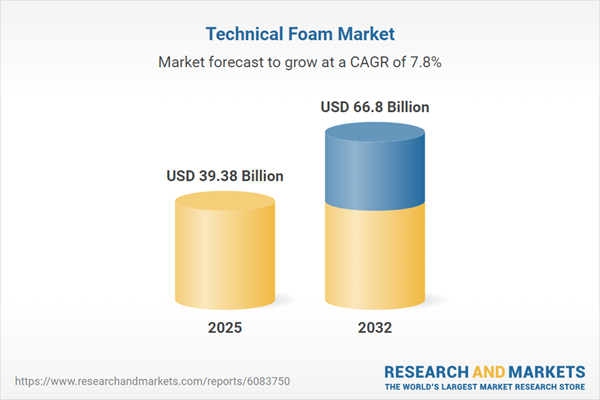Speak directly to the analyst to clarify any post sales queries you may have.
The technical foam market is undergoing significant shifts as sustainability, material innovation, and regulatory change reshape priorities for senior decision-makers. Staying ahead in this industry requires actionable insight into the evolving value chain and the strategies that major players are deploying to capitalize on new sources of demand.
Market Snapshot: Technical Foam Market Trends and Growth
The technical foam market grew from USD 36.56 billion in 2024 to USD 39.38 billion in 2025 and is projected to reach USD 66.80 billion by 2032, registering a CAGR of 7.82%. This growth reflects robust uptake across transportation, construction, electronics, and healthcare, where technical foam delivers insulation, cushioning, thermal control, and acoustic management. Market dynamics are further shaped by advancements in polymer science, increasing expectations for advanced functional properties, and evolving regulatory frameworks, prompting both new entrants and established players to refine their approaches and deepen stakeholder engagement throughout the supply chain.
Scope & Segmentation: Detailed Breakdown
- Product Type: Flexible options include ethylene vinyl acetate, polyethylene, and polyurethane; rigid formats comprise phenolic, polystyrene, and polyurethane; semi-rigid solutions are based on polyethylene and polyurethane chemistries.
- Application: Addressing buoyancy, cushioning, filtration, sealing, sound insulation, and thermal insulation across diverse operating environments.
- End Use Industry: Enabling critical functions within aerospace and defense, automotive, construction, electronics and electrical, healthcare, and marine applications.
- Resin Type: Materials include elastomeric (EPDM, nitrile rubber, silicone), thermoplastic (PE, PS, PVC), and thermoset (epoxy, phenolic, polyurethane) resins, tailored to meet distinct operational requirements.
- Process: Extrusion, injection molding, reaction injection molding, slab stock, and spray techniques provide manufacturers with the versatility to address custom and high-volume requirements efficiently.
- Density: High, low, medium, and ultra-low density foams offer differentiation for performance in specific technical environments.
- Source: Supply chains now increasingly prioritize bio-based, petrochemical, and recycled feedstocks, reflecting pressure to reduce environmental footprints.
- Distribution Channel: Direct sales, distributors, e-commerce, and OEM networks facilitate access across end-user segments and geographies.
- Geographic Regions: Coverage includes the Americas, EMEA, and Asia-Pacific regions, with key focus areas such as the United States, Germany, China, and India, alongside emerging growth markets in Latin America, Africa, and Southeast Asia.
- Leading Companies: The market landscape is shaped by BASF SE, Covestro AG, Dow Inc., DuPont de Nemours, Inc., Huntsman International LLC, Armacell International S.A., Sekisui Chemical Co., Ltd., Wacker Chemie AG, Recticel NV, and Rogers Corporation.
Key Takeaways for Senior Decision-Makers
- Sustainability requirements accelerate adoption of biobased and recycled technical foam, compelling companies to adapt procurement and investment practices for long-term viability.
- Strategic partnerships and localized supply chains boost resilience and support reduced lead times, helping manufacturers remain agile as the market landscape evolves.
- Digital and additive manufacturing technologies provide new levels of design flexibility and customized technical foam characteristics, increasing quality assurance for specialized end uses.
- Compliance pressures, particularly stringent across European markets, are expediting transitions to green resins and recyclable foam formats, broadening the scope of regulatory alignment.
- Technical foam adoption is diversifying beyond legacy sectors, with electronics and medical devices seeking advanced insulation and lightweight solutions to address emerging performance needs.
- Investment in research and development is strengthening the sector’s ability to offer next-generation foam materials with targeted properties required by high-specification applications.
Tariff Impact: Market Implications
Recent tariffs introduced in the United States have driven up costs for imported foam materials and essential polymers. This shift is prompting manufacturers to reprioritize procurement by sourcing from local suppliers and investing in regional production capabilities. These adaptive strategies have directly impacted procurement planning in the automotive and aerospace sectors, initiated collaborative cost-sharing models, and strengthened overall supply chain resilience amid ongoing trade uncertainties.
Methodology & Data Sources
This technical foam market analysis synthesizes secondary data from industry reports, trade journals, regulatory filings, and proprietary databases, augmented by primary interviews with executives, research and development leaders, and procurement specialists. Analytical frameworks, including Porter’s Five Forces and scenario modeling, underpin the structured insights provided.
Why This Report Matters: Strategic Outcomes
- Build strategic clarity on the direction of material science advancements, evolving supply chain models, and innovation catalysts in the technical foam sector.
- Identify and prioritize regional growth opportunities by aligning your business with evolving sector regulations and rising end-use demands.
- Effectively benchmark organizational performance against industry leaders and optimize your investment in sustainable, digital, and supply-driven technologies to sharpen market positioning.
Conclusion
The technical foam market remains characterized by rapid innovation, ongoing regulatory adaptation, and sustained emphasis on environmental considerations. Senior executives and teams can leverage these insights to refine strategy, drive cross-functional collaboration, and reinforce competitive positioning within this dynamic landscape.
Table of Contents
3. Executive Summary
4. Market Overview
7. Cumulative Impact of Artificial Intelligence 2025
Companies Mentioned
The companies profiled in this Technical Foam market report include:- BASF SE
- Covestro AG
- Dow Inc.
- DuPont de Nemours, Inc.
- Huntsman International LLC
- Armacell International S.A.
- Sekisui Chemical Co., Ltd.
- Wacker Chemie AG
- Recticel NV
- Rogers Corporation
Table Information
| Report Attribute | Details |
|---|---|
| No. of Pages | 191 |
| Published | November 2025 |
| Forecast Period | 2025 - 2032 |
| Estimated Market Value ( USD | $ 39.38 Billion |
| Forecasted Market Value ( USD | $ 66.8 Billion |
| Compound Annual Growth Rate | 7.8% |
| Regions Covered | Global |
| No. of Companies Mentioned | 11 |









